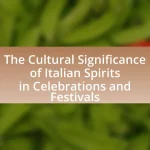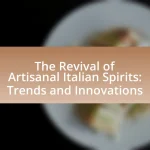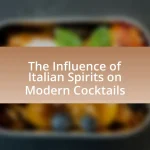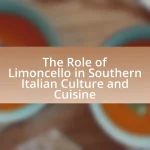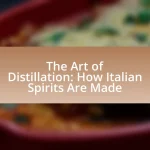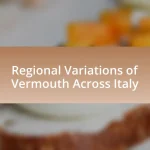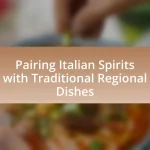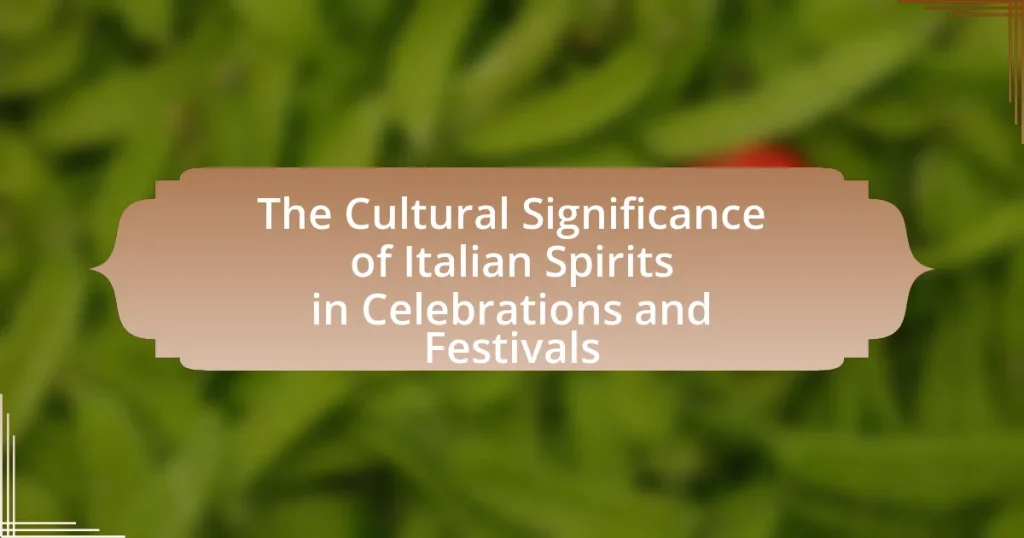The article explores the cultural significance of Italian spirits, such as grappa, limoncello, and amaro, in celebrations and festivals across Italy. It highlights how these spirits serve as symbols of heritage, community bonding, and regional traditions, enhancing the festive atmosphere during events like weddings and local festivals. The article also examines the influence of local ingredients on the production of these spirits, the role they play in social gatherings and rituals, and the historical factors that have shaped their use in celebrations. Additionally, it discusses contemporary trends in the consumption of Italian spirits, the challenges they face in global markets, and best practices for incorporating them into festive occasions.
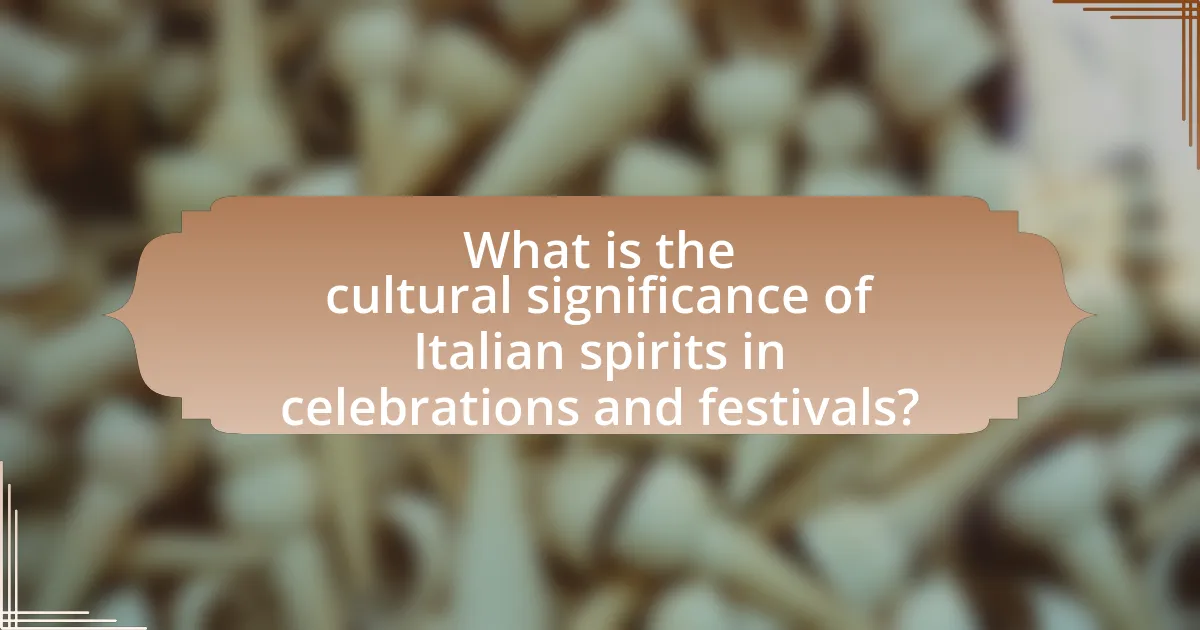
What is the cultural significance of Italian spirits in celebrations and festivals?
Italian spirits hold significant cultural importance in celebrations and festivals, serving as symbols of heritage and community bonding. These spirits, such as grappa, limoncello, and amaro, are often integral to traditional rituals and social gatherings, enhancing the festive atmosphere. For instance, during Italian weddings, it is customary to serve limoncello as a digestif, reflecting regional pride and culinary traditions. Additionally, festivals like the Feast of San Gennaro in Naples prominently feature local spirits, showcasing their role in celebrating cultural identity and fostering social connections among participants. The consumption of these spirits not only enriches the celebratory experience but also reinforces communal ties and the transmission of cultural practices across generations.
How do Italian spirits reflect regional traditions during celebrations?
Italian spirits embody regional traditions during celebrations by showcasing local ingredients, production methods, and cultural practices unique to each area. For instance, Grappa from the northern regions utilizes grape pomace, reflecting the area’s winemaking heritage, while Limoncello from the Amalfi Coast highlights the region’s abundant lemon cultivation. These spirits are often integral to traditional festivities, such as the use of Amaro in family gatherings or the serving of Prosecco during weddings, illustrating how local customs and flavors are interwoven into celebratory practices. The distinctiveness of these spirits not only enhances the celebratory experience but also preserves and promotes regional identities within Italy’s diverse cultural landscape.
What are the most popular Italian spirits associated with specific festivals?
The most popular Italian spirits associated with specific festivals include Grappa, Limoncello, and Amaretto. Grappa is often consumed during the harvest festivals in regions like Piedmont, celebrating the grape harvest, while Limoncello is a staple during summer festivals in the Amalfi Coast, particularly during the Feast of Saint Andrew. Amaretto is frequently enjoyed during Christmas celebrations, especially in Lombardy, where it is used in traditional desserts. These spirits not only enhance the festive atmosphere but also reflect regional traditions and local ingredients, reinforcing their cultural significance in Italian celebrations.
How do local ingredients influence the production of these spirits?
Local ingredients significantly influence the production of Italian spirits by imparting unique flavors and characteristics that reflect regional identities. For instance, the use of locally sourced fruits, herbs, and grains in spirits like Grappa and Limoncello not only enhances the taste but also connects the beverage to its geographical origins. This practice is rooted in tradition; for example, Limoncello is made from Sorrento lemons, which are renowned for their aromatic zest, thus ensuring that the spirit embodies the essence of the Amalfi Coast. Additionally, the incorporation of indigenous botanicals in spirits such as Amaro contributes to a diverse flavor profile that varies from one region to another, showcasing local agricultural practices and cultural heritage.
Why are Italian spirits integral to social gatherings and rituals?
Italian spirits are integral to social gatherings and rituals because they embody cultural traditions and enhance communal experiences. These beverages, such as grappa and limoncello, are often served during meals and celebrations, fostering a sense of togetherness and hospitality. Historically, Italian spirits have been used in various rituals, from toasting at weddings to celebrating holidays, reinforcing social bonds and cultural identity. The act of sharing these spirits symbolizes unity and joy, making them essential components of Italian social life.
What role do Italian spirits play in family and community bonding?
Italian spirits play a significant role in family and community bonding by serving as a medium for social interaction and cultural expression. In Italian culture, sharing spirits such as grappa or limoncello during meals and celebrations fosters connections among family members and friends, reinforcing relationships and traditions. For instance, during festive occasions like weddings or holidays, the act of toasting with these spirits symbolizes unity and shared joy, creating lasting memories and strengthening communal ties. Additionally, the preparation and enjoyment of traditional spirits often involve family recipes passed down through generations, further enhancing the sense of belonging and continuity within the community.
How do rituals involving Italian spirits vary across different regions?
Rituals involving Italian spirits vary significantly across different regions, reflecting local customs, beliefs, and historical influences. For instance, in Sicily, the Feast of the Dead honors deceased ancestors with offerings of food and drink, while in Naples, the cult of the “Animale” involves rituals to appease spirits of the deceased through music and dance. In contrast, the northern regions, such as Trentino-Alto Adige, incorporate Alpine traditions, where rituals may include the use of herbs and natural elements to invoke spirits. These regional differences are rooted in historical contexts, such as the influence of various cultures and religions, which shape how communities engage with their spiritual heritage.
What historical factors have shaped the use of Italian spirits in celebrations?
The use of Italian spirits in celebrations has been shaped by a combination of regional traditions, agricultural practices, and historical events. For instance, the production of spirits like grappa and limoncello is deeply rooted in Italy’s agricultural heritage, where local ingredients such as grapes and lemons are transformed into celebratory beverages. Additionally, the influence of the Roman Empire established a culture of toasting and drinking during social gatherings, which has persisted through centuries. The Renaissance period further popularized the consumption of spirits in festive contexts, as art and culture flourished, leading to the integration of these beverages into various celebrations. Furthermore, the unification of Italy in the 19th century helped standardize and promote regional spirits, making them integral to national celebrations and local festivals.
How have historical events influenced the popularity of certain spirits?
Historical events have significantly influenced the popularity of certain spirits, particularly in Italy, where cultural shifts and social changes have shaped consumption patterns. For instance, the introduction of vermouth in the 18th century coincided with the rise of the aperitivo culture in Italy, reflecting a societal shift towards leisure and socialization. Additionally, the Prohibition era in the United States led to a resurgence of interest in Italian spirits like grappa and amaro, as immigrants sought to preserve their cultural heritage through traditional drinks. These events demonstrate how historical contexts, such as economic changes and migration patterns, directly impact the popularity and cultural significance of specific spirits in celebrations and festivals.
What cultural exchanges have impacted the evolution of Italian spirits?
Cultural exchanges that have impacted the evolution of Italian spirits include the influence of Arab, Spanish, and French cultures. The introduction of distillation techniques by Arab traders in the Middle Ages significantly advanced the production of spirits in Italy, leading to the creation of high-quality liquors. Spanish colonization brought new ingredients, such as sugar and citrus fruits, which were incorporated into Italian liqueurs like limoncello. Additionally, French influence during the Renaissance introduced sophisticated blending and aging techniques, enhancing the complexity of Italian spirits. These exchanges collectively shaped the diverse landscape of Italian spirits, reflecting a rich tapestry of cultural interactions.
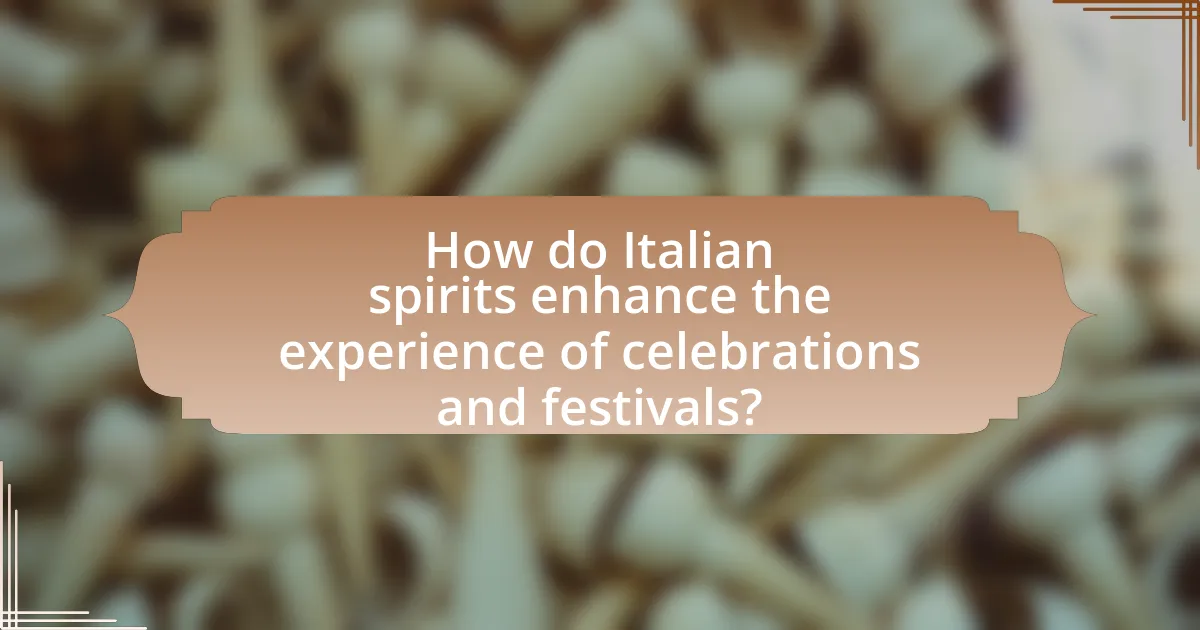
How do Italian spirits enhance the experience of celebrations and festivals?
Italian spirits enhance the experience of celebrations and festivals by serving as integral components of social rituals and cultural traditions. These spirits, such as limoncello, grappa, and amaro, are often consumed during communal gatherings, symbolizing hospitality and joy. For instance, in Italy, the tradition of toasting with prosecco during weddings and festive occasions fosters a sense of unity and celebration among participants. Additionally, the use of regional spirits reflects local heritage and craftsmanship, enriching the cultural narrative of the event. Historical practices, such as the production of grappa dating back to the 19th century, further illustrate the deep-rooted connection between these beverages and Italian cultural identity, making them essential to the celebratory atmosphere.
What sensory experiences do Italian spirits contribute to festivities?
Italian spirits contribute to festivities through a rich tapestry of sensory experiences, primarily encompassing taste, aroma, and visual appeal. The distinct flavors of spirits like limoncello, grappa, and amaretto enhance celebratory meals, offering a unique taste that reflects regional ingredients and traditions. The aromas of these spirits, often infused with herbs, fruits, or spices, create an inviting atmosphere that engages the sense of smell, evoking memories and emotions associated with cultural heritage. Visually, the vibrant colors of these spirits, from the bright yellow of limoncello to the deep amber of aged grappa, add to the festive ambiance, making gatherings more visually stimulating. These sensory experiences not only elevate the enjoyment of food and drink but also foster social connections and cultural identity during celebrations.
How do flavors and aromas of Italian spirits enhance traditional dishes?
Flavors and aromas of Italian spirits enhance traditional dishes by adding depth and complexity to the overall culinary experience. For instance, the herbal notes of vermouth can elevate a classic risotto, while the citrusy zest of limoncello can brighten seafood dishes. These spirits often contain a blend of botanicals, fruits, and spices that complement the ingredients in traditional recipes, creating a harmonious balance of flavors. Historical practices, such as using grappa in sauces, demonstrate how these spirits have been integrated into Italian cuisine for centuries, enriching the taste profiles of various dishes.
What is the significance of toasting with Italian spirits during celebrations?
Toasting with Italian spirits during celebrations signifies a deep-rooted cultural tradition that emphasizes community, joy, and shared experiences. This practice is often accompanied by specific rituals, such as raising glasses and making eye contact, which foster a sense of connection among participants. Historically, Italian spirits like Prosecco, Grappa, and Limoncello have been integral to festive occasions, symbolizing prosperity and good fortune. For instance, Prosecco is frequently used in toasts during weddings and New Year celebrations, reflecting its association with happiness and new beginnings. The act of toasting not only enhances the celebratory atmosphere but also reinforces social bonds, making it a vital component of Italian cultural heritage.
How do Italian spirits foster a sense of identity during festivals?
Italian spirits foster a sense of identity during festivals by serving as cultural symbols that connect communities to their heritage. These spirits, such as grappa and limoncello, are often produced using traditional methods passed down through generations, reflecting regional characteristics and local ingredients. For instance, the production of limoncello in the Amalfi Coast highlights the area’s unique lemons and artisanal techniques, reinforcing local pride and identity. Festivals centered around these spirits, like the Grappa Festival in Piedmont, celebrate not only the beverages themselves but also the stories, traditions, and communal experiences associated with them, thereby strengthening social bonds and cultural continuity.
What symbols are associated with Italian spirits in cultural celebrations?
Symbols associated with Italian spirits in cultural celebrations include the grapevine, which represents wine production and is central to many festivities, particularly during harvest time. Additionally, the olive branch symbolizes peace and prosperity, often featured in religious and cultural events. The use of traditional masks, especially during Carnival, signifies the spirit of festivity and transformation. These symbols are deeply rooted in Italy’s agricultural heritage and reflect the importance of community and celebration in Italian culture.
How do Italian spirits represent heritage and pride in local communities?
Italian spirits embody heritage and pride in local communities by serving as symbols of regional identity and traditional craftsmanship. Each spirit, such as grappa from the Veneto region or limoncello from the Amalfi Coast, reflects local ingredients, historical production methods, and cultural practices unique to that area. For instance, grappa is made from the pomace of grapes, a practice that dates back centuries, showcasing the resourcefulness of Italian winemakers. Additionally, these spirits are often featured in local festivals and celebrations, reinforcing community bonds and cultural continuity. The production and consumption of these beverages during communal events highlight their role in preserving traditions and fostering a sense of belonging among residents.
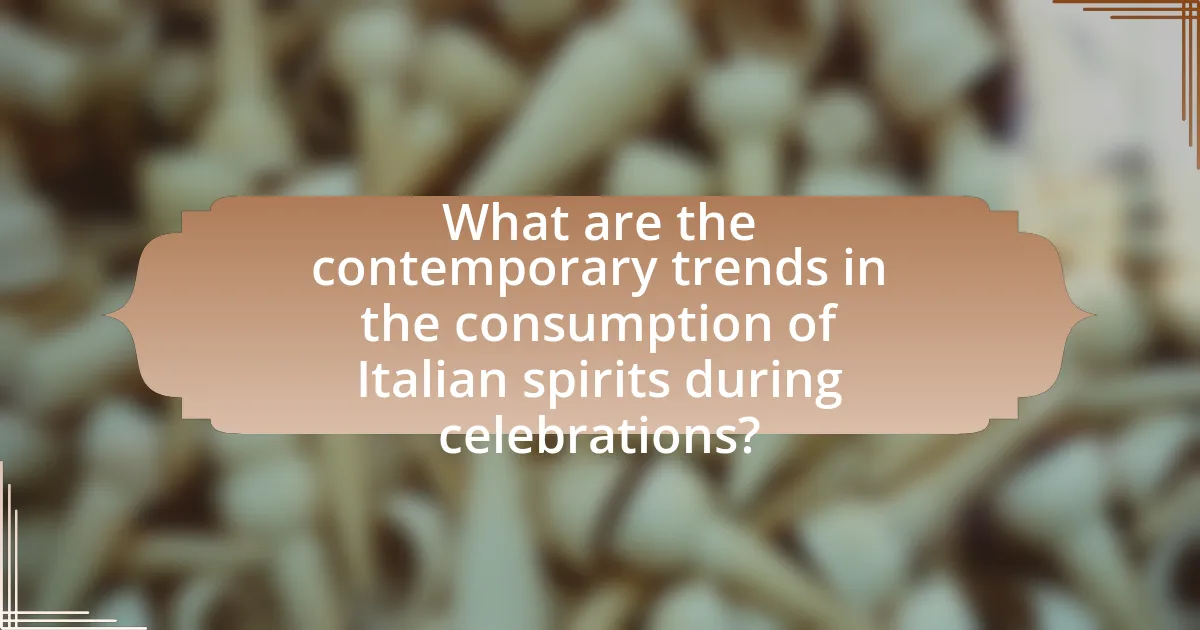
What are the contemporary trends in the consumption of Italian spirits during celebrations?
Contemporary trends in the consumption of Italian spirits during celebrations include a growing preference for artisanal and craft spirits, particularly those that emphasize traditional production methods and local ingredients. This shift is evidenced by the increasing popularity of products like artisanal grappa and vermouth, which are often featured in celebratory cocktails and served at social gatherings. Additionally, there is a notable rise in the consumption of Italian aperitifs, such as Aperol and Campari, which are commonly enjoyed during pre-dinner festivities, reflecting a cultural trend towards socializing and enjoying leisurely meals. The trend is supported by market research indicating that the Italian spirits market has seen a significant increase in sales, with a reported growth rate of approximately 5% annually over the past few years, highlighting the evolving preferences of consumers during celebrations.
How are modern interpretations of Italian spirits influencing traditional celebrations?
Modern interpretations of Italian spirits are revitalizing traditional celebrations by introducing innovative flavors and presentation styles that appeal to contemporary tastes. For instance, craft distilleries are experimenting with local botanicals and unique aging processes, resulting in spirits that enhance traditional cocktails and aperitifs, such as Negronis and Spritzes. This evolution not only attracts younger audiences but also encourages the integration of these spirits into festive occasions, thereby preserving cultural practices while adapting to modern preferences. The rise of mixology events and spirit tastings during festivals further exemplifies this trend, showcasing how traditional Italian spirits can be reimagined to create engaging experiences that resonate with today’s celebrants.
What innovative cocktails are being created using traditional Italian spirits?
Innovative cocktails using traditional Italian spirits include the Negroni Sbagliato, which substitutes prosecco for gin, and the Spritz, combining Aperol or Campari with prosecco and soda water. These cocktails reflect Italy’s rich cocktail culture, showcasing the versatility of spirits like vermouth, grappa, and amaro. The Negroni Sbagliato gained popularity due to its refreshing twist, while the Spritz is celebrated for its vibrant flavor and social appeal, often enjoyed during Italian aperitivo hours.
How are younger generations engaging with Italian spirits in festivals?
Younger generations are engaging with Italian spirits in festivals through interactive experiences, such as tastings and mixology workshops. These activities allow participants to explore the rich heritage and diverse flavors of Italian spirits like grappa and limoncello. For instance, events like the “Italian Spirits Festival” in New York City showcase local distilleries and offer hands-on sessions, attracting a younger demographic eager to learn about traditional production methods and innovative cocktail recipes. This engagement reflects a growing trend among millennials and Gen Z to appreciate artisanal products and cultural authenticity in their culinary experiences.
What challenges do Italian spirits face in the context of global celebrations?
Italian spirits face significant challenges in the context of global celebrations, primarily due to intense competition from other international beverages and the need for effective branding. The global market is saturated with diverse alcoholic options, making it difficult for Italian spirits to stand out. Additionally, cultural differences can hinder the acceptance and appreciation of Italian spirits in various regions, as local preferences often dictate consumption patterns. For instance, while Italian aperitifs like Aperol and Campari have gained popularity, they still compete against established local drinks in markets such as the United States and Asia. Furthermore, regulatory barriers and import restrictions can limit the availability of Italian spirits in certain countries, impacting their visibility during global celebrations.
How do globalization and changing tastes affect the popularity of Italian spirits?
Globalization and changing tastes significantly enhance the popularity of Italian spirits by increasing their accessibility and appeal to diverse consumer preferences. As international markets expand, Italian spirits such as limoncello and grappa gain visibility, leading to greater demand in countries outside Italy. For instance, the global market for Italian spirits has seen a growth rate of approximately 5% annually, driven by the rising interest in craft cocktails and authentic Italian experiences. Additionally, evolving consumer preferences towards premium and artisanal products align with the quality and heritage of Italian spirits, further boosting their popularity. This trend is evidenced by the increasing number of Italian spirit brands entering foreign markets and the growing presence of Italian-themed bars and restaurants worldwide.
What strategies are being employed to promote Italian spirits in international markets?
Italian spirits are being promoted in international markets through targeted marketing campaigns, collaborations with mixologists, and participation in global trade shows. These strategies aim to enhance brand visibility and educate consumers about the cultural heritage and unique qualities of Italian spirits. For instance, brands often showcase their products at events like the International Wine and Spirits Fair, where they can engage directly with potential customers and industry professionals. Additionally, partnerships with renowned bartenders help create signature cocktails that highlight the versatility of Italian spirits, further driving interest and sales in diverse markets.
What are some best practices for incorporating Italian spirits into celebrations?
To incorporate Italian spirits into celebrations effectively, one should focus on pairing them with traditional Italian dishes, as this enhances the overall dining experience. For instance, serving Aperol Spritz as an aperitivo before meals complements antipasti, while pairing Grappa with dessert can elevate the tasting experience. Additionally, creating signature cocktails using Italian spirits, such as Negroni or Bellini, can add a unique touch to the celebration. It is also beneficial to educate guests about the origins and cultural significance of the spirits being served, as this fosters appreciation and enhances the celebratory atmosphere. These practices are rooted in Italian culinary traditions, where food and drink are integral to social gatherings, making the experience more authentic and enjoyable.
